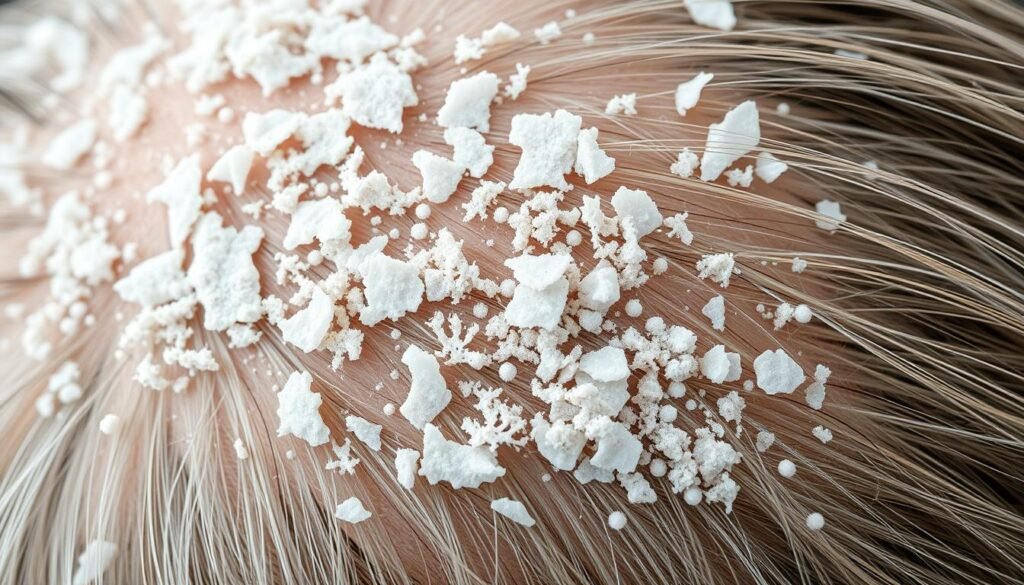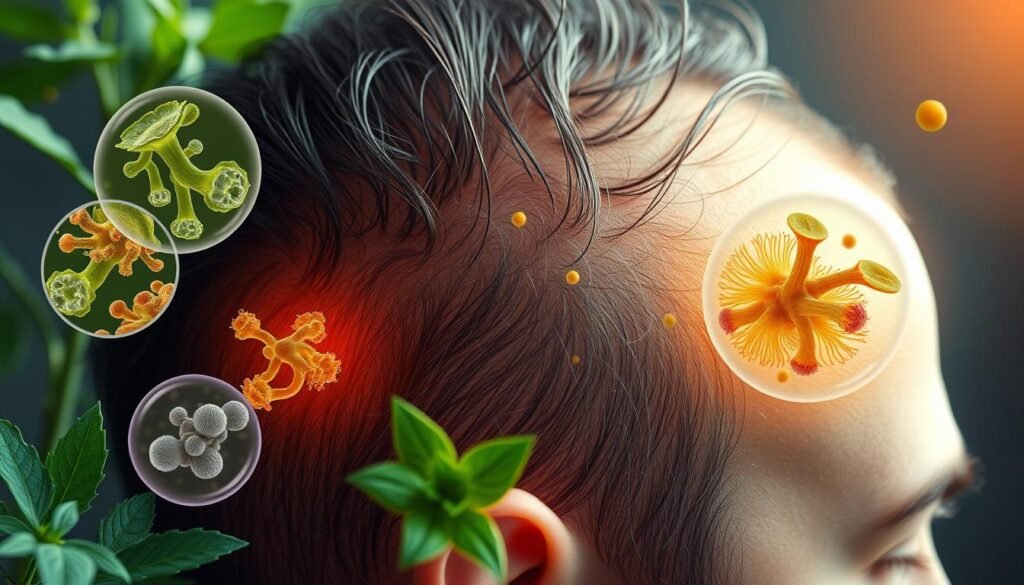Have you ever wondered why dandruff pops up, even with good scalp health? The answer might be in the unseen world of fungal infections. Tiny organisms, like Malassezia, can upset the balance on our scalps. This upset leads to the annoying flakes we call dandruff. Knowing this link is key to fighting off dandruff.
This article unveils how fungal invaders can mess with scalp balance, causing dandruff. We’ll share insights and tips for a flake-free scalp.
Key Takeaways
- Fungal infections play a significant role in the onset of dandruff.
- The scalp microbiome consists of various microorganisms, including fungi like Malassezia.
- Recognizing the symptoms of dandruff can lead to better treatment options.
- Home remedies and antifungal shampoos can be effective against dandruff.
- Maintaining optimal scalp health is essential for preventing dandruff.
- Consulting a dermatologist can provide professional insights for stubborn cases.
Understanding Dandruff
Dandruff is a common scalp issue that makes the skin flake, itch, and dry out. Many people face this problem, which varies in how severe it is. Not only is it uncomfortable, but it can also make one feel less confident. This is especially true when the flakes show on clothes.
What is Dandruff?
Dandruff comes from the scalp shedding dead skin cells. This leads to annoying white or yellowish flakes. Reasons include dry or oily skin, or reactions to hair products. Sometimes, it’s tied to skin issues like Seborrheic Dermatitis. This condition causes inflammation, redness, and irritation.
Types of Dandruff
Knowing the different dandruff types is key to managing it. There are two main kinds:
- Dry Dandruff: This happens when the scalp lacks moisture, creating small, white flakes. It’s common among those with dry skin.
- Oily Dandruff: This is due to too much oil, leading to bigger, yellowish flakes. It tends to itch more and be uncomfortable.
Seborrheic Dermatitis is a major dandruff form. It’s linked to a yeast-like fungus in oily skin and often needs special treatment. For more on causes and treatment options, check out this resource. Knowing about dandruff types helps people find the right treatment for them.
The Role of the Scalp Microbiome
The scalp microbiome is a community of microorganisms living on our heads. This ecosystem is key to a healthy scalp. It includes various bacteria and fungi. These help keep the scalp balanced, preventing disorders like dandruff.
Knowing this balance’s importance helps us care for our scalp and hair better.
What is the Scalp Microbiome?
Billions of microorganisms, including bacteria and fungi, make up the scalp microbiome. They work together to protect the scalp against harmful pathogens. A healthy microbial community keeps the skin healthy and supports strong hair growth. An unbalanced microbiome can cause skin issues, showing how crucial balance is.
How Fungi Impact Scalp Microbiome Balance
Fungi have a big effect on the scalp microbiome’s balance. Malassezia fungi, for example, can cause inflammation and problems like dandruff when they grow too much. This leads to poor scalp health. Studies offer insights into treating dandruff by understanding fungi’s role. For more details, see this study on fungi and the scalp.
Fungal Infections and Dandruff
Fungal infections are key in causing dandruff, a frequent issue for many. These infections, mainly from skin fungi, lead to scalp flaking and irritation. This happens because of inflammation.
Connection Between Fungal Infections and Dandruff
Studies show a strong link between fungal infections and dandruff. A disrupted balance of scalp microbes lets certain fungi grow too much. This growth causes the skin to react by flaking and itching. Knowing how this works helps find good dandruff treatments.
Common Fungi Associated with Dandruff
A yeast called Malassezia is often behind dandruff. It loves the warm, oily places like the scalp. While other fungi can also cause trouble, Malassezia is the main problem. Dealing with these fungi is vital for controlling fungal infections and dandruff.
Understanding Malassezia
Malassezia is a type of fungus that lives on human skin. It helps keep our scalp healthy. But, if it grows too much, it can cause conditions like dandruff.
What is Malassezia?
There are many kinds of Malassezia, including Malassezia globosa and Malassezia restricta. They love oily places like our scalp. Normally, they’re harmless and help break down oils on our scalp.
How Malassezia Causes Dandruff
Too much Malassezia can irritate our skin. This leads to dandruff through the shedding of skin cells. Studies show that more Malassezia means more severe dandruff.

Seborrheic Dermatitis: A Symptom of Fungal Infection
Seborrheic Dermatitis is a skin issue that comes and goes. It’s linked to fungus on the skin. It shows up in oily spots like the scalp, face, and upper back. Knowing its signs and what causes it helps control it better.
What is Seborrheic Dermatitis?
This condition makes skin red and scaly. People feel discomfort and embarrassment, especially when it appears on the face. It’s partly caused by a yeast named Malassezia. This is why certain treatments are really effective.
Symptoms and Causes
The symptoms of Seborrheic Dermatitis typically include:
- Flaky scales on the scalp or face
- Red patches of skin
- Severe itching
- Greasy or oily skin appearance
Many things lead to Seborrheic Dermatitis. Hormone shifts and stress can make it worse. A weak immune system also affects its severity. For solutions, dandruff supplements help. They reduce inflammation and make the scalp healthy again.
| Symptom | Description |
|---|---|
| Flaky Scales | Small pieces of dry skin that may accumulate, especially on the scalp. |
| Red Patches | Inflamed areas of skin that can be uncomfortable and sensitive. |
| Severe Itching | A common symptom that may lead to scratching, causing further irritation. |
| Oily Skin Appearance | Skin looks greasy due to excess oil production, often worsened by inflammation. |
Identifying Fungal Infections
Spotting fungal infections early is key to treating them right. Look out for several common signs that suggest fungi. Knowing these signs helps take quick action to stop more problems.
Common Signs of Fungal Infections
- Itching: A main sign of fungal infections, often with discomfort.
- Scaling: Flaky skin on the scalp might mean a fungal problem.
- Redness: Visible redness can point to inflammation from fungal infections.
- Flaky Scalp: White or yellow flakes could show, much like dandruff but usually worse.
- Hair Thinning: Fungal issues can lead to hair loss or thin spots on the scalp.
Diagnostic Methods
Diagnosing fungal infections involves a few steps. Doctors first look for common signs on the scalp. Then, lab tests, like cultures or microscope checks, might confirm fungi. These diagnostic methods make sure the problem is correctly identified to start the right treatment.

Treating Dandruff Caused by Fungal Infections
Dandruff can be annoying and is often due to fungal infections. Treating it means using both home remedies and special products. These methods can make your scalp healthy again and stop the itchiness.
Home Remedies
Many home remedies are popular for fighting dandruff. Effective ones include:
- Tea Tree Oil: With its anti-fungal features, tea tree oil can greatly lessen dandruff.
- Apple Cider Vinegar: This remedy helps balance scalp pH and cuts down on fungal growth.
- Aloe Vera: Known for its calming effects, aloe vera can ease irritation and moisturize the scalp.
Adding these remedies to your hair care can help your scalp. And they’re gentle on your hair too.
Why Antifungal Shampoos Are Essential
Using antifungal shampoos is key for dandruff from fungal issues. These shampoos have things like pyrithione zinc, ketoconazole, or selenium sulfide. They go after the fungi directly. Using these regularly can cut down on extra skin cells on the scalp and get rid of itchiness.
If dandruff stays even with home remedies, looking into medical advice might help. Mixing home remedies with antifungal shampoos can better the odds of having a dandruff-free scalp.
Maintaining Scalp Health
Caring for your scalp is key to having healthy hair. A healthy scalp environment fights off dandruff and fungal infections. It’s important to actively take care of your scalp.
Importance of Scalp Care
Scalp care is the base of healthy hair growth. Issues like irritation, dryness, and hair loss stem from an unhealthy scalp. Caring for your scalp means controlling oil, keeping it moisturized, and nourishing hair roots.
Tips for Healthy Scalp and Hair
- Choose the Right Shampoo: Pick shampoos with natural ingredients for scalp health and avoid harsh chemicals.
- Wash Smart: Use warm water and don’t wash your hair every day to keep natural oils.
- Moisturizing Products: Use conditioners and leave-in treatments to keep your scalp moisturized.
- Balanced Diet: Eat foods rich in vitamins and minerals that help scalp health, like vitamins A, C, D, and E.
- Regular Scalp Massages: Scalp massages increase blood flow, bringing nutrients to the hair roots.

Dermatological Treatments for Fungal Infections
Fungal infections can lead to skin issues like never-ending dandruff. Knowing when to get help is key. Signs and symptoms tell you it’s time to see a dermatologist. This can stop worse problems.
When to See a Dermatologist
Make an appointment if you have:
- Persistent itching or irritation that doesn’t get better with store-bought treatments.
- Redness or inflammation that sticks around for days.
- Severe dandruff that gets in the way of daily life.
- Signs of infection, like pus, blisters, or swelling.
Quickly dealing with these signs is vital. It helps stop bigger issues caused by fungal infections.
Professional Treatment Options
Treatments at the dermatologist’s are customized for fungal infections. Options include:
- Prescription Antifungal Medications: Dermatologists might give you creams or pills that attack the fungus.
- Medicated Shampoos: Special shampoos can help control and lessen dandruff.
- Corticosteroid Creams: These can help calm inflammation and comfort your skin.
- Light Therapy: For tough infections, light therapy might be an option.
Getting help gives you the tools to fight fungal infections. It helps keep your scalp and skin healthy.
| Treatment Type | Description | Use Cases |
|---|---|---|
| Prescription Antifungal Medications | Target specific fungi causing the infection | Severe cases or stubborn infections |
| Medicated Shampoos | Shampoos with active antifungal ingredients | Persistent dandruff management |
| Corticosteroid Creams | Reduce inflammation and soothe irritation | Allergic reactions or severe irritation |
| Light Therapy | Uses light to target and kill fungi | Severe fungal infections unresponsive to other treatments |
Conclusion
The link between fungal infections and dandruff is key. Knowing about these skin issues is crucial. Factors like hormone changes and genes can make dandruff worse. This happens often because of fungal infections. By understanding the signs and causes, we can better treat and prevent them.
Keeping your scalp healthy is vital for good hair. Washing your hair often and using antifungal shampoos helps a lot. These steps reduce dandruff and improve scalp health. For more tips on dealing with dandruff, check out this link for treatment options and prevention advice.
Knowing about fungal infections and their effect on the scalp is very important. With the right treatment and a complete care plan, fighting dandruff is possible. This way, you can keep your scalp healthy for a long time.